.
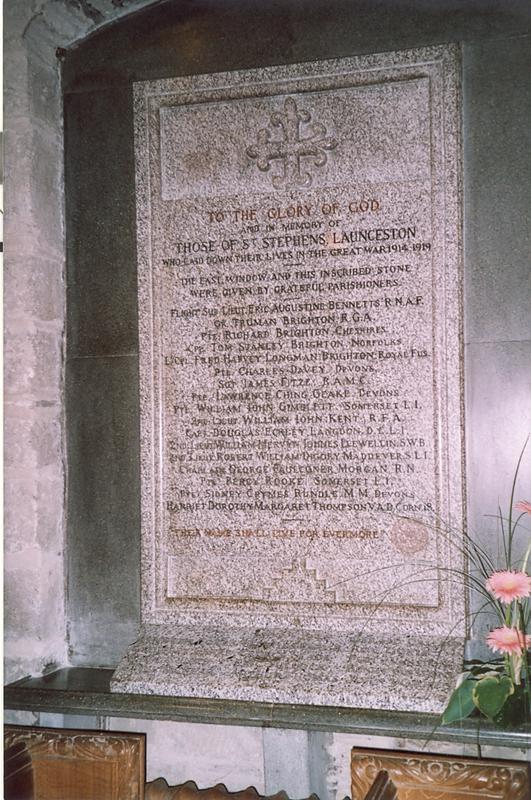
First World War
TO THE GLORY OF GOD/ AND IN MEMORY OF/ THOSE MEN OF ST STEPHEN, LAUNCESTON/ WHO LAID DOWN THEIR LIVES IN THE GREAT WAR 1914 – 1919/ THE EAST WINDOW AND THIS INSCRIBED STONE/ WERE GIVEN BY GRATEFUL PARISHIONERS.
Eric Augustine BENNETTS
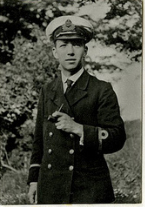
Eric was born on the 28th of August 1895 at St. Agnes to Thomas and Annie Bennetts. His Father was a Clergyman and was the Vicar of Lewannick (Where Eric spent most of his childhood) up to 1914 when the family moved to Cape Town, South Africa. He attended Hazeldon Preparatory School, Tavistock, Devon before going to Sherborne School (The Green) from September 1909 to July 1913, he was a scholar in the 6th form. He won the Digby Maths prize in1913. He completed his studies at a college in Cape Town. He originally was a Lance-Corporal in the Cape Town Highlanders, South African Defence Force (Signalling Instructor) but in the spring of 1916 he returned to England to join the Royal Flying Corp (R36035) and became a Flight Sub Lieutenant in the Royal Navy Air Service. He was reported missing in September 1917 after his plane, a Sopwith Camel F1 biplane, collided with another British Sopwith, piloted by Philip Johnston, behind enemy lines and was confirmed as having died in February 1918.He is buried at the Cabaret-Rouge British Cemetery, Souchez, epartement du Pas-de-Calais, Nord-Pas-de-Calais, France, Plot: XV. R. 22.
On the 26th of February 1918 a service of commemoration was held at Lewannick Church with the tributes being paid: Floral tribute – “In loving memory of dear Eric from Commander & Mrs Watts Russel. From all at Pen Tamar.”Floral tribute – “In proud & loving memory of Eric & those who fell in the Great War from this Parish. Mrs & Miss Bennetts of Lifton.”Floral tribute – “In proud & loving memory of Eric Augustine Bennetts & all those who from this Parish fell in the Great War, from Rev. & Mrs W.T. Bennetts.
At the time of his death, his Sister, Evelyn Maud Bennetts, was living at Roydon Road, Launceston, the address he used as a place of residence. For this reason he is mentioned on the St. Stephens Church roll of honour. Augustine
Fred Harvey Longman BRIGHTON
Fred was born in 1890 at 4 Devon View, Launceston to Truman and Agnes Brighton. The youngest of eight sons, six of whom served in the war with only two surviving. Truman Brighton was an auctioneer but died on the 17th April 1900 leaving the sum of £368 19s 8d to Agnes. Fred moved to London with his Brother Richard and they both worked for Cooks, 16 Stamford Street, Southwark as a wholesale Manchester warehouseman.
Fred joined the 10th Royal Fusiliers (City of London Regiment) as Lance Corporal (Regimental No. Sth/920) and was killed in action serving with the 10th Battalion on the 23rd April 1917. He is buried at Chili Trench Cemetery, Gavrelle and is commemorated on the Launceston War Memorial and St Stephens Church Roll of Honour.
Taken from the Battalion’s war diary:
21 April 1917 – Battalion moved via Athies to trenches. Two Companies in front line approx between points H II.b.68 and H 5 b.4.5. One company in support approx between points H II, a. 88 and H 5a.88, in position at 11.30pm. Several patrols sent out to reconoitre and try to connect with other brigades. (At this point the Battalion was situated behind Cuba Trench close to Chili Trench.) Battalion occupied Cuba Trench about 9.30am 23 April 1917.
Richard BRIGHTON
Another of Truman and Agnes Brighton’s Sons, Richard was born in 1884 at Werrington which was in the county of Devon at the time. He first started working as a Draper but on moving to London worked for Cooks, 16 Stamford Street, Southwark as a wholesale Manchester warehouseman along with his Brother Fred. By the outbreak of War, Richard had married Annie Victoria Brighton, and was living at 4, Brockenhurst Rd., Addiscombe, Croydon. He first joined the East Kent Regiment (Regimental No. 5453) but transferred to the Cheshire Regiment ‘D’ Company 11th Battalion (Regimental No. 243050) He was killed in action on the 20th April 1918. He was interred in the Strand Military Cemetery, Hainaut, Belgium VII. O. 5. and is also commemorated on the Launceston War Memorial and St. Stephens Church Roll of Honour.
The 20th April was described in the Battalion War Diary as being quiet and the men were in camp on the road between Mont-des-Cats and Godersvelde. It is, of course, possible that in the chaos of the preceding days, many men had been attached to another unit and were killed in further fighting.
Truman BRIGHTON
Another Son of Truman senior and Agnes Brighton to perish, Truman was born in 1878 at a Cottage in Newport, Launceston. By the 1911 census he was living at 109 Haviland Road, Boscombe, Bournemouth and working as a Builders Merchant assistant which he was still occupied in at the time of his enlistment in 1915. He was living with his wife Elizabeth (Nee Harris, whom he married in 1911) at 29 Wheaton Road, Bournemouth at that time they had two Daughters, Nora and Kathleen. He joined the Royal Garrison Artillery (Regimental No. 107816) on the 10th December 1915. He served as a Gunner with the 336 Siege Battery, receiving two separate postings with the B.E.F in France. On the 29th June 1918 he was gassed and was evacuated to No. 39 Stationary Hospital before being invalided back to England on the 17th of August 1918. On the 4th of February 1919 he was officially demobbed but never recovered from his injuries and died in March 1920 at Christchurch, Hampshire. He was interred in the Bournemouth East Cemetery, R. 2. 167. and is also commemorated on the Launceston War Memorial and St. Stephens Church Roll of Honour.
Thomas Stanley BRIGHTON
Thomas, the fourth son of the late Truman and Agnes Brighton to fall, was born in 1881 at St. Stephens, Launceston. At the age of 20 he was working as a Printers apprentice still living with his widowed Mother, but a further 10 years on he had moved to 53 Mill Hill Rd, Norwich and his occupation was listed as a compositor. It is from here that he joined the Norfolk Regiment 1/4th Battalion (Regimental No 200634). He was killed in action on the 19th April 1917 during the 2nd battle of Gaza in Palestine. He is buried at Jerusalem Memorial, Jerusalem, Yerushalayim, Israel, Plot: Panels 12 to 15 and is also commemorated on the Launceston War Memorial and St. Stephens Church Roll of Honour.
At the outbreak of the First World War, Palestine (now Israel) was part of the Turkish Empire and it was not entered by Allied forces until December 1916. The advance to Jerusalem took a further year, but from 1914 to December 1917, about 250 Commonwealth prisoners of war were buried in the German and Anglo-German cemeteries of the city.
Charles DAVEY
Charles was born in 1892 at North Street, St. Stephens, Launceston to John and Caroline Davey. John Davey was a Coal Barker. In the 1911 census Charles is still living with his parents and working as a Domestic Groom. He joined the Devonshire Regiment 8th Battalion as a Private (Regimental No 45674). He was injured whilst fighting in France and died of his wounds on the 10th April 1917. He was interred at the Etaples Military Cememtery, Pas de Calais, France, XXII. F. 14A he is also commemorated on the Launceston War Memorial and St. Stephens Church Roll of Honour.
With the German retreat to the Hindenburgh line in mid March 1917, the Allied patrols having discovered the German withdrawal began to follow with their armies. 91st Brigade and 20th Brigade attacked on 2nd April, 91st Brigade, 2nd Queen’s (Royal West Surrey Regiment), 21st Manchester Regiment and 1st South Staffordshire Regiment captured Croisilles and 20th Brigade, 2nd Gordon Highlanders, 8th Devonshire Regiment, of which Charles was a member, and 9th Devonshire Regiment, captured the two Ecoust villages.
James S FITZE

James was born in 1877 to William and Emma Fitze at 16 Duke Street, St. Stephens, Launceston. He had 3 elder Brothers and two elder Sisters. His Father was an agricultural worker. In the 1901 census he is working as a Boots Domestic at the Farley’s Hotel, Plymouth but before 1902 he had already joined up with the Royal Army Medical Corps (Regimental No 15804) serving in South Africa during the Boer War. On one occasion he was taken prisoner. He spent a total of 5 years in South Africa. In the 1911 census he is shown as a cook being stationed at the Military Hospital, Fulford Road, York working in the isolation block.
By the time war had broken out, he had been promoted to the rank of Sergeant. He was serving at the 5th casualty clearing station on the 4th September 1914 when killed. He is buried at the Saint Sever Cemetery Extension, Rouen, Departement de la Seine-Maritime, Haute-Normandie, France, Plot: S. 1V. L. 6. His name is also commemorated on the Launceston War Memorial and St. Stephens Church Roll of Honour.
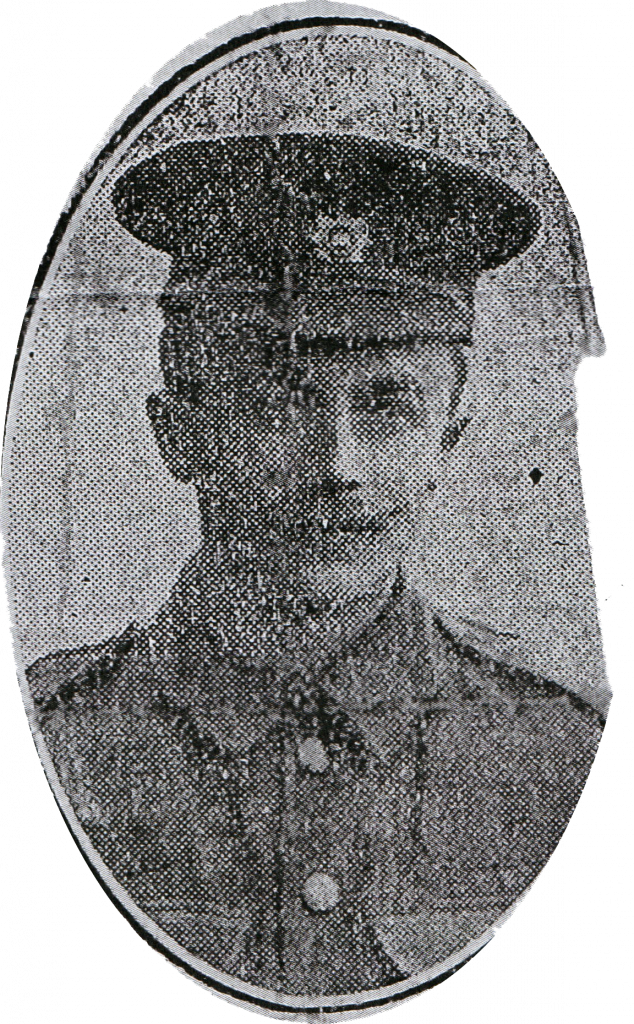
Lawrence was born in 1888 to John and Jeanie Geake at St. Stephens, Launceston. His Father was a Mineral Water Manufacturer. He attended Shebbear College. He became a Gardener and in the 1911 census is shown as a visitor to Mr. Frederick Lintern, Little Rexon, Broadwood along with his wife Jessie and new born son Edward. He joined the 8th Battalion Devonshire regiment in 1914 as a Private (Regimental No 10200) enlisting at Plymouth.
Like so many in the 8th (including two other Lanson Lads) he perished on the Loos Battlefield on the 25th September 1915. His body was never recovered but his name is commemorated on the Launceston War Memorial, St. Stephens Church Roll of Honour and the Loos Memorial Loos Memorial Panel 35 to 37.
The Battle of Loos was the first genuinely large scale British offensive action but once again only in a supporting role to a larger French attack in the Third Battle of Artois. British appeals that the ground over which they were being called upon to advance was wholly unsuitable were rejected. The battle is historically noteworthy for the first British use of poison gas. Compared with the small-scale British efforts of spring 1915, this attack of six Divisions was a mighty offensive indeed – so much so that it was referred to at the time as ‘The Big Push’. Taking place on ground not of their choosing and before stocks of ammunition and heavy artillery were sufficient, the opening of the battle was noteworthy for the first use of poison gas by the British Army. Despite heavy casualties, there was considerable success on the first day in breaking into the deep enemy positions near Loos and Hulluch. But the reserves had been held too far from the battle front to be able to exploit the successes and succeeding days bogged down into attritional warfare for minor gains. When it was fought it was the largest land battle in British military history, witnessing the first British use of poison chlorine gas (in bulky cylinders placed in the front line), and the debut of elements of Lord Kitchener’s New Army (composed of citizen volunteers), which had been raised after the outbreak of war. It was also the first time the British experienced the huge cost of major continental campaigns, suffering over 60,000 casualties in little over three weeks – with, on average, British divisions suffering a higher number of men killed in action than would be seen on the infamous 1 July 1916, ‘the first day on the Somme’. Yet this remains largely unknown.
William John GIMBLETT
William was born in 1892 to William and Mary Gimblett at St. Stephens, Launceston. His Father was an Agricultural Worker but died in 1894. In 1911 he was working at High Hall Farm, Laneast for Mr. Whitford as a Carter.
He first joined the Duke of Cornwall’s Light Infantry as Private 15599, but later transferred to the Somerset Light Infantry 8th Battalion as Private (Regimental No. 15177) as part of the 63rd Brigade. He died (His left arm had been badly shattered and had been amputated) of his wounds sustained in battle of the Somme – (Battle of Albert) on the 6th July 1916 and is buried at the Le Treport Military Cemetery , Le Treport, Departement de la Seine-Maritime, Haute-Normandie, France, Plot: Plot 2. Row O. Grave 2A. His name is also commemorated on the Launceston War Memorial and St. Stephens Church Roll of Honour.
William John KENT
William was born in 1885 to William and Emmeline Kent at Torquay. His father was a Police constable with the Devon county constabulary. His parents came to live at Truscott by 1914 with his father now serving with the Cornwall constabulary. William joined the the Royal Field Artillery in 1905. He was given a commission in 1914 on the field of battle for conspicuous bravery. Now a 2nd Lieutenant and after a few days leave at Christmas 1915 where he married Bertha Ellacott at North Petherwin church, he returned to France. On the 11th of March his battery were ordered up to take part in the battle of Neuve Chappelle. On the morning of the 12th, a shell burst close to him, killing William and another soldier, and wounding eight others of his battery. He was buried on the spot he fell. William appears on the St. Stephens ‘Roll of Honour’. His brother Frederick Thomas Kent also served during the war also being awarded a commission.
Douglas Eckley LANGDON
Douglas was born at Huelva, Spain on the 3rd of April 1884 to William and Eleanor Langdon of Kensey Launceston. He was educated at Ipswich Grammar School and in April 1900 began an apprenticeship at the works of Saxby and Farmer, Chippenham.
In 1903, he entered the service of the Great Western Railway as improver for four years in their locomotive works at Newton Abbot, Devon and passed through the fitting, erecting, machine shops, and drawing office. During the period of his apprenticeship and subsequently, he attended Technical schools at Bath, Chippenham, and Newton Abbot. He was elected a Graduate of this Institution in 1908, and an Associate Member in 1911
In September 1907 he entered the service of the Buenos Aires and Pacific Railway in the drawing office at Junin, Argentina, and in the following February he was sent as assistant shed foreman to Villa Mercedes. Two years later he became assistant to the Divisional Locomotive Superintendent at Justo Dorset until the following January, when he was promoted to take charge of the Company’s running-shed at Beazley. On the outbreak of War in August 1914 he immediately applied for and obtained leave to go home, and on the day following his arrival in London he enlisted in A Company of the Public Schools and Universities Corps then just forming (afterwards 18th Batt. London Royal Fusiliers). He was offered a Commission in the Duke of Cornwall’s Light Infantry in May 1915, and in September 1916 he was promoted Acting Captain abroad. In March of the same year he was sent out at night with a small party to repair the wire in front of their trenches, and was hit below the knee by a rifle bullet. After being in the Red Cross Hospital at Rouen for eight weeks he returned to his battalion at the front. On the night of the 22nd-23rd April 1917 he took his Company into action and was killed instantly while clearing the enemy out of some ruined houses. In this action all the officers of the Company were killed or wounded. He was thirty-three years of age. He is buried at the Sucrerie Cemetery, Ablain-Saint-Nazaire, Departement du Pas-de-Calais, Nord-Pas-de-Calais, France, Plot: I. A. 18. He is also commemorated on the Launceston War Memorial and St. Stephens Roll of Honour.
William Mervyn Johnes LLEWELLYN

William or Mervyn as he was known, was born on the 5th of May 1898 to Thomas Johnes Llewellyn and Ann Elizabeth Llewellyn in Westgate Street, Launceston. His Father, a Welshman, was a Solicitor and had moved to Launceston to become the Magistrates Clerk but by 1914 was the Mayor and Chairman of the Launceston Rural District Council. Mervyn attended Upcott House preparatory school, Okehampton, Devon and the from May 1913 to December 1916 he attended Sherborne School (School House); scholar; 6th form; Prefect; Head of School House; 2nd XV rugby football team.
After leaving Sherborne in 1917 he went to Sandhurst. He joined the South Wales Borderers 1st Battalion as a 2nd Lieutenant in December 1917, joining the 3rd Battalion and going to the 1st Battalion in France in April 1918. Slightly wounded in June 1918, but as his regiment was short of officers he remained at duty. On the 17th of August 1918 at Cambrai, he along with a Sergeant and Lance Corporal set of on a dangerous scouting mission in an attempt to gather intelligence enemy. It was in darkness that they set off, but unfortunately they were seen. Both Mervyn and the Sergeant were killed, with the Lance Corporal being taken prisoner.
Mervyn’s obituary appeared in ‘The Shirburnian’, February 1919:
‘2nd Lieut. William Mervyn Johnes Llewellin, South Wales Borderers (a 1913-16), who was reported missing in August, was killed instantaneously on August 17th, by a German bomb while on patrol with two soldiers. One of the two was killed also, and the other taken prisoner: the latter has now returned home and reported the facts. Mervyn Llewellin came to the School House in May 1913, having been delayed for two terms by serious illness. His school life was a splendid struggle against ill health and a remarkable victory. He would never admit to the slightest feeling of illness until he was absolutely compelled to do so, and insisted on doing everything in work and play that the healthiest boy could do whenever possible. Before he left he reached the Upper VIth, was head of the School House, and in the 2nd XV. On leaving school he went to Sandhurst in January, 1917, and was gazetted to the South Wales Borderers in December of that year, joining the 3rd Battalion and going to the 1st Battalion in France in April, 1918. He was slightly wounded in June, but, as the regiment was short of officers, he remained at duty.’
He is buried at the Saint Mary’s Advanced Dressing Station Cemetery, Haisnes, Departement du Pas-de-Calais, Nord-Pas-de-Calais, France, Plot: XI. F. 20. The same Cemetery as Rudyard Kipling’s Son John Kipling is buried. He is also commemorated on the Launceston War Memorial and St. Stephens Roll of Honour.
Robert William Digory MADDEVER
Robert was born in 1893 to William and Margaret Maddever at 15 Duke Street, St. Stephens, Launceston. His Father was a General Carter (Timber Haulier). His Father died in 1911. He was educated at Horwell Boys Grammar School and Camelford Grammar School and went on to become a school teacher. According to reports he was a keen athlete being associated with Launceston Football, Cricket, Tennis and Bowling clubs. He first volunteered for active service with the Cornwall territorials on the 24th April 1915 and gained rapid promotion being made Quartermaster Sergeant on the 16th December 1915. He obtained a commission and was made 2nd Lieutenant of the Somersetshire Light Infantry 4th Battalion on the 20th of July 1917 with whom he fought with in France and Flanders from the 10th September 1917. He died near Ypres on the 22nd of October 1917 of wounds he received in action the same day during the Third Battle of Ypres. He is commemorated at the Tyne Cot Memorial, Zonnebeke, West Flanders (West-Vlaanderen), Belgium Panel 41 to 42 and 163A and also the Launceston War Memorial and St Stephens Roll of Honour. He left a widow in Margaret of 15, Duke St., St. Stephens, Launceston.
George William Faulconer MORGAN
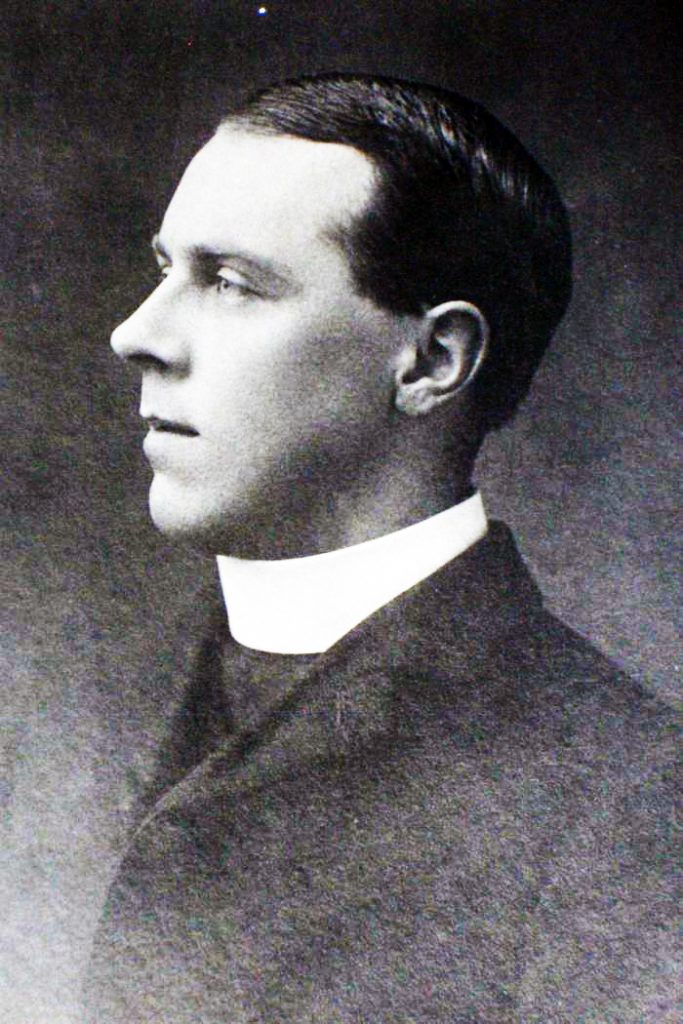
George was born in 1878 to James Hill Faulconer and Amelia Morgan. He studied at Pembroke College (entering in 1900), Cambridge where he obtained a BA in the Mathematical Tripos (June Opt.) in 1903 and trained for the Priesthood at Wells Theological College in 1903. He was made a Deacon in 1904 and ordained Priest by the Bishop of Exeter in 1905 serving his Title as Curate of Stoke Damarel from 1904-06, when he became a Chaplain to the Royal Navy. Formerly Lieutenant in the 12th (Suffolk) Regiment, he served on HMS Prince of Wales 1906–07; HMS Venus 1907–08; at the RN College, Osborne 1908-09 then HMS Berwick 1909 –10; HMS Challenger 1910–12; HMS Powerful 1912–13 and HMS Impregnable 1913–15. He was serving aboard ‘H.M.S. Invincible’ when she was sunk at the Battle of Jutland on the 31st of May 1916. His body was never recovered but he is commemorated on the Portsmouth Naval Memorial Panel Ref: 1, also on the Northam War Memorial, the St Margaret’s Book of Remembrance, the R.N.D.Golf Club WW1 Memorial Board and the St Stephens Roll of Honour.
HMS Invincible was an Invincible Class battle cruiser built at Vickers Armstrong, Elswick, Newcastle upon Tyne in 1909. The Flagship of Admiral Sir Horace Lambert Alexander Hood, she was sunk by SMS Derfflinger and Lutzow the latter being badly damaged by HMS Invincible. The entire ship’s company of 1026 were lost.
Percy ROOKE

Percy was born in 1899 to William and Sarah (nee Johns) at Sutcombe, Holsworthy, Devon. His Father was a General Labourer. On leaving school he worked for the Printers, Messrs W. S, Cater and Co. in Launceston.
He enlisted at Launceston with the Somerset Light Infantry (Regimental No. 40127) serving with the 8th Battalion. By then the family were living at New Mills, St. Stephens. He died of his wounds possibly sustained during the Battle of Albert on the August 24th 1918 and is buried at the Bienvillers Military Cemetery, Bienvillers-au-Bois, Departement du Pas-de-Calais, Nord-Pas-de-Calais, France, Plot: XIX. F. 5. He is also commemorated on the St Thomas Church Roll of Honour and St. Stephens Church Roll of Honour. At the time of his death, his parents were living at Trethorne Gate near Tregadillet.
Battle of Albert (21–23 August 1918) was the third battle by that name fought during World War I, following the First Battle of Albert and the Second Battle of Albert, with each of the series of three being fought roughly two years apart. This smaller third battle was significant in that it was the opening push that would lead to the Second Battle of the Somme and involved the Australian Corps. This attack opened the advance, with the main attack being launched by the Third Army along with support from the Fourth Army. The Second Battle of Bapaume, from August 25th to September 3rd, was a continuation of this battle.
The attacks developed into an advance, which pushed the German 2nd Army back along a 50-mile front line. On August 22nd, the 18th (Eastern) Division took Albert, with the British and Americans advancing on Arras.On August 29th, during the Second Battle of Bapaume, the town of Bapaume fell into New Zealand hands. This resulted in an advance by the Australian Corps, who crossed the Somme River on 31 August and broke the German lines during the Battle of Mont St. Quentin. The Westheer (German armies on the Western Front) was pushed back to the Hindenburg Line, from which they had launched their spring offensive.
Sydney Crymes RUNDLE
Sydney was born in 1888 to John Kingdom and Hannah (nee Baker) Rundle at North Petherwin. His father was a farmer and Butcher and the family were living at Colhay farm, St. Stephens in 1911. He married Lillian Kate Bloye of Egloskerry in 1915. Sydney enlisted at Launceston with the Devonshire Regiment as a Lance Corporal (Regimental No. 30443) serving with the 2nd Battalion. He was killed in action during the Second Battle of Villers-Bretonneux on April 24th 1918. His body was never identified but his name is commemorated on the St. Stephens ‘Roll of Honour’.
The Second Battle of Villers-Bretonneux (also Actions of Villers-Bretonneux, after the First Battles of the Somme, 1918) took place from 24th to 25th April 1918, during the German Spring Offensive to the east of Amiens. It is notable for being the first occasion on which tanks fought against each other; it was the biggest and most successful tank action of the German army in the First World War.
Harriet Dorothy Margaret THOMPSON
Harriet was born in 1893 to Dr. William ‘Willie’ Fookes and Harriet Thompson at Launceston. Her Father was the local GP for Launceston, living at Penquite, Launceston. Harriet followed her Father into the Medical Practice and became a Nurse. With the onset of war she joined the Volunteer Aid Detachment and helped look after injured Soldiers. She unfortunately contracted TB from one on the soldiers she had been nursing and as the illness worsened, she returned home to Launceston to be looked after by her Father. She died in the September of 1918.
The Cornwall & Devon Post, dated 27 July, 1918, carried the sad news: “Death. Thompson, on July 22nd, at Penquite, Launceston, Harriet, Dorothy Margaret, only daughter of Dr and Mrs Thompson.”
In the same edition: “Miss Thompson’s Death. Great sympathy with the Mayor and Mayoress. The residents of the borough of Launceston have extended very real sympathy to the mayor and mayoress in the death of their only daughter, at the early age of 26 years. At the outbreak of war Miss Thompson enrolled as a helper in the Launceston V.A.D. Hospital, and while engaged as a nurse in a Brighton hospital some months since, she had a serious breakdown in health. Nurse Thompson came home to die. She had thus virtually given her life for her country. Her remains were laid to rest in St Stephen churchyard on Wednesday afternoon. The funeral was one of the largest witnessed of recent years. The coffin, covered with the Union Jack, was placed on a bier and wheeled to the church by a St John Ambulance squad. Seven carriages followed the bier. The procession was a long one. The attendance was so enormous that there was not room in the church for all.”
There followed a long list of mourners- family, servants, Councillors, etc. The bearers were members of the St John Ambulance and British Red Cross Society, and former orderlies at the VAD Hospital, comprising – Messrs: JR Quick, SC Mutton, LP Symons, AS Keat, WH Philp and WT Mills; with Mr. CS Atkins in charge. Rifleman G Wicks, Croix de Guerre, blew ‘Last Post’. She is commemorated on the Launceston War Memorial and on the St Stephens Church Roll of Honour.
Second World War
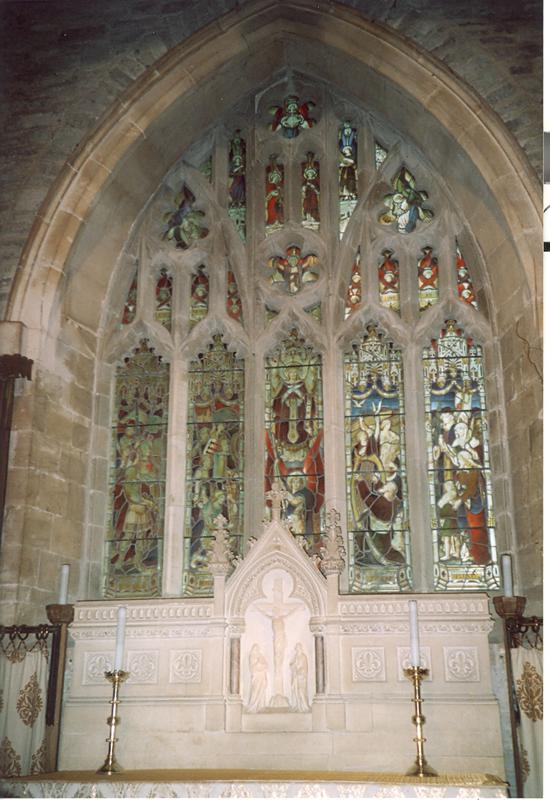
Large east window of five lights depicting biblical scenes. Lights depicting the following: war; devastation; Christ in Majesty above St. Michael and the dragon; peace; plenty. Tracery depicts angels with instruments and twelve seraphs. Also dedicatory rectangular tablet set on a slate backboard with a carved cross at the top and the dedication below in black lettering. The first line and last are in red lettering.
THEIR NAME LIVETH FOR EVERMORE/ 1939 – 1945/
Gerald Ivor CALLOW
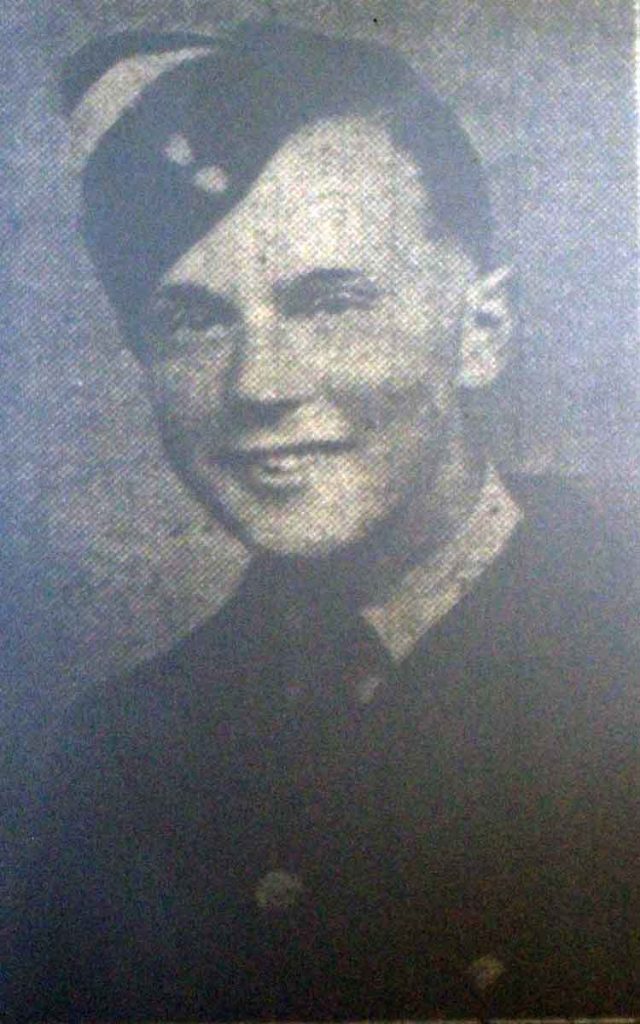
Gerald was born in 1925 to John and Flossie Callow at Langore, St. Stephens. On leaving school he was employed by Messrs. Miller and Son, florists, etc. and later he went to the Admiralty to work. He was a keen sportsman and was well known in singing circles having been a member of the Truscott Methodist Church Choir for some time and was also a valued member of the Sunday School. He had been a prominent member of 1559 Squadron, A.T.C., and the training he received stood him in good stead on joining the R.A.F. as a Air-Gunner (Service No.3032826). He had just been promoted to Sergeant and had been due to come home on promotion leave just a couple of weeks before he was killed in a flying accident between two Wellington bombers (HF517 & MF589) whilst on active service on the night of the 26th of August 1944. He was buried at Truscott Chapel, St. Stephens. Gerald is remembered on a plaque at a garden centre in Prestwood, Buckinghamshire, near where the plane came down. He is also commemorated on the St Stephens Roll of Honour.
On the night of Friday 25 August 1944 the two aircraft took off and were airborne one minute apart to practice a night exercise termed a ‘bullseye’. This involved a cross country flight incorporating several different turning points that could be situated anywhere in the UK and was meant to give trainee crews experience that would bind them together into a cohesive unit. Along the route they would probably make a dummy bombing attack on a specified town.
The first Wellington HF517 was piloted by Flying Officer Erik Michielsen (Dutch) and the British crew consisted of Pilot Officer Ronald Junor (navigator), Pilot Officer John Sutherin (Air Bomber), Sergeant James Clarke (Wireless Operator), Sergeants John Butterfiled and Gerald Callow (Air Gunners). The second Wellington MF589 was piloted by Flying Officer Elwood Smith (Canadian) and crewed by four Canadians Flying Officer Vernon Bolton (Navigator), Flying Officer Norman Cousins (Air Bomber), Sergeant James McMurtrie (Air Gunner), Sergeant Raymond Sander (Air Gunner) and one Englishman Sergeant John Poston (Wireless Operator).
At 1.25am on the 26 August these two aircraft collided over Prestwood and fell as burning disintegrating wrecks into the village. Of the twelve crew members, eleven were killed, the survivor Pilot Officer Junor was found wandering in adazed condition in Lodge Wood. In the official report following the collision the conclusion was ‘ failure by both crews to keep an adequate look out’
Kenneth William COCK
Kenneth was born in 1919 to Frederick William and Annie Cock at Launceston. He enlisted with the Royal Navy (Service No. D/KX 91135) as a Stoker First Class. H e was serving aboard ‘HMS Ardent’ when it was sunk on the 9th of June 1940. His body was never recovered but his name is commemorated on the the Plymouth Naval Memorial Panel 41 column 1. He is also commemorated on the Launceston War Memorial and St Stephens Roll of Honour.
HMS Ardent was detached from Ark Royal on the 8th of June, and joined Acasta in escorting Glorious back to Scapa Flow. En route, the three ships were discovered by the German warships Scharnhorst and Gneisenau. Ardent and Acasta laid a protective smokescreen to hide the British ships, and engaged the German ships with her 4.7 in (120 mm) main armament, which proved to be ineffective at the range of the targets. Despite coming under heavy fire from the much larger guns of the Germans, Ardent carried out a torpedo attack. She managed to score a single hit with her 4.7 in (120 mm) gun, but was struck repeatedly by enemy shells. Ardent eventually capsized with the loss of 10 officers and 142 ratings. Acasta and Glorious were also sunk in the engagement.
Geoffrey William GEAKE
Geoffrey was born in 1913 to Mr and Mrs Lawrence Geake (His Mothers maiden name was Lintern) at Tavistock. By 1942 the family had moved to Duke Street, St. Stephens, Launceston. He enlisted with the Royal Navy serving as an Able Seaman (Service No. D/JX185481). He was serving aboard ‘HMS Jupiter’ when she was sunk off the north Java coast in the Java Sea on 27 February 1942, at 2116 hours, by a mine laid earlier in the day by the Dutch minelayer Gouden Leeuw. Initially, the explosion was thought to be caused by a Japanese torpedo. Geoffrey was killed in the explosion. His body was never recovered but his name is commemorated on the Plymouth Naval Memorial Panel 65 column 1. He is also commemorated on the Launceston War Memorial and St Stephens Roll of Honour.
Archie Edward JURY
Archie was born in 1911 to Edward and Louisa Jury at Windmill Cottage, Launceston. His Father worked as a Mason. In 1934 he married Elsie May Browning in Launceston. He joined the Royal Navy (Service No. D/KX 79574) as a Leading Stoker serving aboard HM Submarine Tempest. He was killed on the 23rd of February 1942. He was mentioned in dispatches and although his body was never recovered his name is commemorated on the Plymouth Naval Memorial and also on the Launceston War Memorial and St Stephens Roll of Honour.
HMS Tempest sailed from Malta on the night of 10 February 1942 to patrol the Gulf of Taranto. On the evening of the 11th Tempest was signalled that the Italians were aware of a submarine in her vicinity and that it should be assumed that her patrol had been compromised. On the 13th, Tempest was sighted on the surface by the Italian destroyer Circe. Tempest crash dived and Circe began depth charging the area, eventually resulting in oil being seen on the surface. Tempest’s battery tanks had burst filling the boat with chlorine gas and the vessel was forced to surface, whereupon she was hit by gunfire from the Circe. The crew abandoned the submarine, and 23 of the crew of 62 were picked up some 3 hours later by the destroyer. The Italians attempted to board the abandoned vessel but were unable to, due to rough seas. Instead, the Italian destroyer opened fire, scoring more than a dozen direct hits, but failing to sink the Tempest. Finally the Italians attempted to take the submarine in tow. Two members of the destroyer’s crew boarded the submarine and prepared the tow. As Circe manoeuvred to take up the tow, Tempest suddenly started to sink, forcing those on board to jump into the sea. The submarine slipped beneath the waves stern-first, with the bows disappearing vertical.
Cecil Fred MENEAR
Cecil was born in 1903 at Truro to Charles and Elizabeth Mary Menear. He married Alice Week Harry and they set home at Lelant Police Station where Cecil was stationed from 1932 whilst serving with the Cornwall Constabulary. He died after an accident whilst on duty it St Ives at Hayle Hospital on March 20th, 1942. The funeral was held at St Stephens Launceston and attended by a police guard of honour. He is commemorated on the St Stephens Roll of Honour and the National Police Memorial.
Charles Wilfred PARISH(the Launceston War Memorial has his initials displayed as G. W.)
Charles was born on November 7th, 1916 to Eli and Florence Parish at Launceston. He married Laura Mary Davey in 1942 and they set up home at 7 Duke Street, St. Stephens, Launceston. In the 1939 register he is showing as a labourer in recreation. He enlisted with the Durham Light Infantry (Regimental No. 5443235) as a Private. Serving with the 6th Battalion in Belgium he was killed in action on the 10th of September 1944 and is buried at the Geel War cemetery.
In his will he left his effects to the sum of £151 14s. 6d. to his wife. He is commemorated on the Launceston War Memorial and St Stephens Roll of Honour.
George SLADE
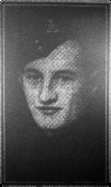
George was born in 1916 at Holsworthy to Francis Charles and Gladys Madeline (nee Horwell) Slade of the square, Holsworthy. His father had served with the Devon Regiment in world was one. He first learnt his trade with Messrs Whitlcok of Holsworthy and went on to work for Messrs Prockter and Kent of Launceston. He was married to Sylvia Bant in 1942 at Lawhitton and had been living with his wife at No 4, Higher Cleaverfield, Launceston. They had one daughter. He enlisted with the The Wiltshire Regiment (Duke of Edinburgh’s) (Regimental No. 5441934) as a Corporal. He was killed in action in Italy on the 9th of May 1944. He is buried at the Beach Head War Cemetery, Anzio, Provincia di Roma, Lazio, Italy, Plot: XIV. G. 4. He is also commemorated on the Launceston War Memorial and St Stephens Roll of Honour.
In May 1944, the Wiltshire Regiment reached Italy and was placed under the command of 78th Division. The Royal Wiltshire Yeomanry was to support 36th Infantry Brigade, with one squadron in support of each of the brigade’s three infantry battalions. In May–June 1944 it took part in the advance on Rome, working its way up in close country between the central mountains and the sea to the west. At one point, 78th Division withdrew but outlying elements of the regiment did not get the message and continued forwards. The Corps HQ diary for 23 June records ‘RWY water truck reports Vaiano clear of enemy’.
(George’s Brother Sapper Charles Slade of the Royal Engineers was a POW of the Japanese).
Eric SULLOCK
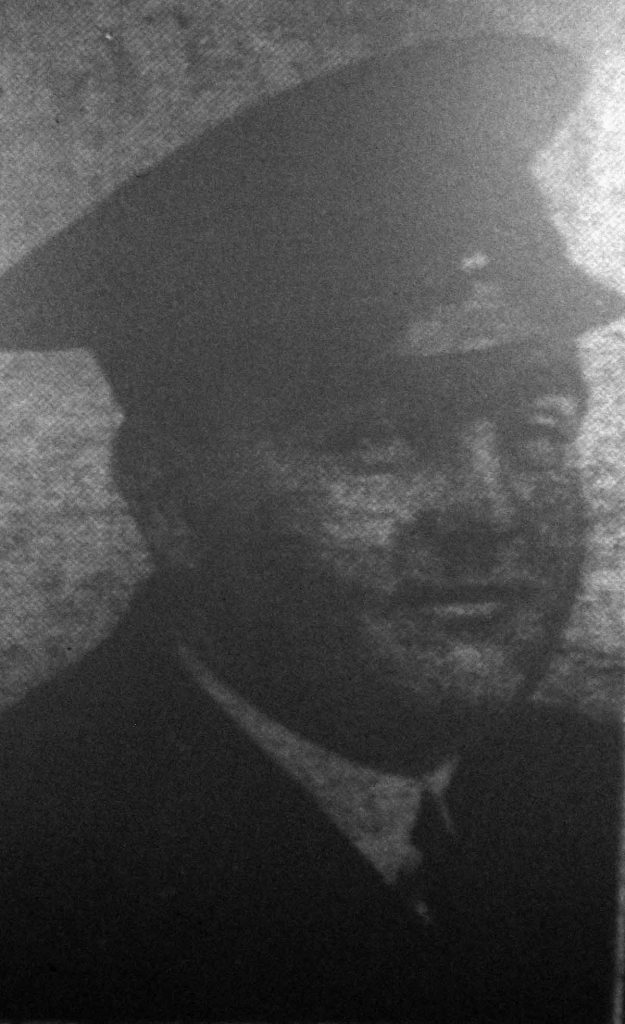
Eric was born in 1919 to John Thomas and Doris Maud (nee Doney) Sullock at Launceston. His Father worked as an Agricultural Labourer. Prior to the war, Eric worked for Mr. Stanley Robbins, Butcher, of St. Stephens Hill. Eric was highly thought of by customers and his employer who held him with high esteem. He was also a highly regarded member of the Launceston Brotherhood.
He joined the Royal Navy on the 13th of June 1940 and became a Leading Steward (Service No. LT/LX 29290) serving with the Royal Navy patrol service aboard ‘HM Trawler Bredon’. He died on the 8th of February 1943. His body was never recovered but his name is commemorated on the Lowestoft Naval Memorial panel 13 column 2. He is also commemorated on the Launceston War Memorial and St Stephens Roll of Honour.
His Majesty’s Trawler Bredon (Pennant Number T223) was a Hill class naval trawler that served as an anti-submarine escort trawler during the Second World War. She was sunk by U-521 on 8 February 1943 while off the Canary Islands. Only 2 souls from her complement of 43 survived. Eric’s body was never recovered.
Arthur William THOMAS
Arthur was born in 1921 to William and Mabel Thomas at 16 Dutson Terrace, Launceston. Arthur joined the Royal Navy as an Able Seaman
(Service No. D/JX 152278) He was serving aboard ‘HMS Furious’ when he died on the 10th of November 1940. He is buried at Bootle Cemetery. He is also commemorated on the Launceston War Memorial and St Stephens Roll of Honour.
Cyril Roy TICKLE
Cyril was born in September 1920 to Mr. and Mrs. William Tickle (Mother nee Lane) at Launceston. His Father worked as a Printer. Cyril attended Launceston College and on leaving went to work for a Bank in Exeter. He was a Gunner with the Royal Artillery (Regimental No. 1461340) serving with 151 Battalion, 51 Light AA Regiment. He was reported as being taken prisoner at Dunkirk in October 1940. However it was later confirmed that he had been killed in action on the 26th of May 1940. His body was never recovered but his name is commemorated on the Dunkirk Memorial panel 15. He left the sum of £833 6s. 7d to his Father William of 5 Shilson Terrace, Launceston. He is commemorated on the Launceston War Memorial and St Stephens Roll of Honour.
William Henry VANSTONE
Henry as we was known, was born in 1913 to William and Annie (nee Northey) Vanstone. Henry enlisted as a Private with the 1st Battalion of the Duke of Cornwall’s Light Infantry (Regimental No. 5436721) and was already a serving soldier when war broke out. The 1st Battalion were already stationed in India when the war began, and they were to remain here until they were ordered to Iraq in 1941. Henry however died whilst serving in India on September 11th, 1940. He was interred in the Karachi War Cemetery in what is now Pakistan, Grave 10. D. 12.. He is commemorated on the St Stephens Roll of Honour.
Percy VANSTONE
Percy was the younger brother of Henry above, born in 1915 to William and Annie (nee Northey) Vanstone. He joined his brother into the 1st Battalion of the Duke of Cornwall’s Light Infantry (Regimental No. 5436720) also as a Private at the same time, so was already serving when war broke out. He was listed as being missing during the Battle of Gazala in May, 1942 but was later confirmed as being held as a Prisoner of War. (Casualty List No. 909. Original source quotes “Prisoner of War (Previously reported as Missing)”. Then, “The following was previously shown on Casualty List No. 867 as Missing, 05/06/1942”.) Now in captivity, Percy was transferred to the Italian mainland, possibly being held at POW Camp 66 near Ancona on the Italian Adriatic coast. Percy died whilst in captivity on December 19th, 1942 and was interred in the Ancona War Cemetery in Italy, III. C. 3. He is commemorated on the St Stephens Roll of Honour.
The Battle of Gazala (near the modern town of Ayn al Ghazālah) was fought during the Western Desert Campaign of the Second World War, west of the port of Tobruk in Libya, from May 26th to June 21st, 1942. Axis troops of the Panzerarmee Afrika (Generaloberst Erwin Rommel) consisted of German and Italian units. Allied forces (Commander-in-Chief Middle East, General Sir Claude Auchinleck) were mainly British (including the 1st Battalion of the DCLI), Indian, South African and Free French.
Rommel secretly had the advantage of detailed advance intelligence of the Allies, resulting from an unwitting breach of communications security by Bonner Fellers a military attaché at the US embassy in Cairo. The most secret data on British “strengths, positions, losses, reinforcements, supply, situation, plans, morale etc” was read by German signals intelligence in Africa, within eight hours of their transmission to Washington. This calamitous situation endured from December 1941 until June 29th, 1942 (after the fall of Tobruk), when the US Black Code was replaced.
The Axis distracted the British with a decoy attack in the north and made the main attack round the southern flank of the Gazala position. The advance succeeded, but the defence of the French garrison of Bir Hakeim, at the southern end of the line, left the Axis with a long and vulnerable supply route around the Gazala line. Rommel retired to The Cauldron, a defensive position backing onto British minefields, forming a base in the midst of the British defences and Italian engineers lifted mines from the west side of the minefields to create a supply route through to the Axis side.
The Eighth Army counter-attack, Operation Aberdeen, was poorly co-ordinated and defeated in detail; many tanks were lost and the Axis were able to regain the initiative. The British withdrew from the Gazala Line and the Axis troops overran Tobruk in a day. Rommel exploited the success by pursuing the British into Egypt, denying them time to recover from the defeat. As both sides neared exhaustion, the Eighth Army managed to check the Axis advance at the First Battle of El Alamein. The battle is considered the greatest victory of Rommel’s career, but Operation Herkules, a plan to attack Malta, was postponed to concentrate on the pursuit. The British managed to supply Malta and revived it as a base for attacks on Axis convoys to Libya, greatly complicating Axis supply difficulties at El Alamein.
Edward John James WARREN

Jack as he was known was born in Camelford in 1918 to Mr and Mrs H. Warren. His mothers maiden name was Rush. The family came to live at Athill farm, Egloskerry by the 1940’s. He enlisted with the Royal Corps Signals in 1937 as a Signalman with the 4th Indian Division Signals (Regimental No. 2325677). He was killed in action on the 20th of June 1942 at during the fall of Tobruk, Libya and was buried at Acroma, Knightsbidge, Libya Grave Ref: Plot 2. Row Grave 12. He is commemorated on the St Stephens Roll of Honour. The inscription on his headstone reads: ‘R.I.P. FONDLY REMEMBERED AT ATHILL ST. STEPHENS, LAUNCESTON, CORNWALL, MOTHER AND ALL‘
Visits: 149
